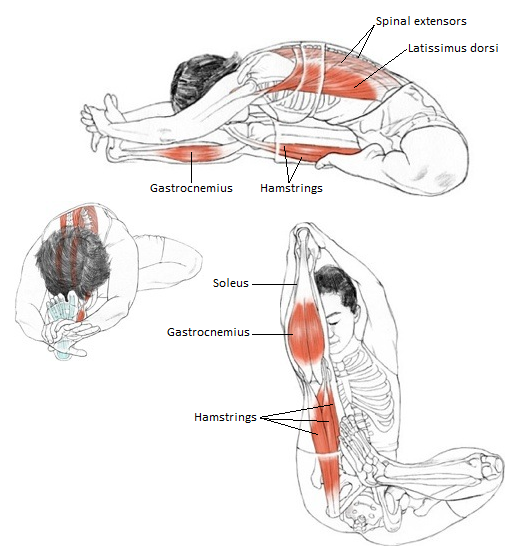Biomechanics: Janu Sirsasana (Head to Knee Pose)

Figure taken from Kaminoff &
Matthews 2012
Janu Sirsasana can reveal inherent asymmetries of the human
body in terms of both the back muscles and the relative
stability or mobility of the SI joints.
Torque is the tendency or ability of a force to rotate an object around a pivot point, where this ability depends on not only the magnitude of the force but also on where the force is applied relative to the pivot point (Knight 2013).The more mobile the SI joint is on the side of the flexed leg, the easier it is to turn and face the extended leg. This is especially true as the spine extends toward the extended leg. As hip flexion deepens, less spinal flexion is required. Because this further limits the rotation in the lumbar spine, more movement then needs to happen at the SI joint.
It is very common to over mobilize the SI joint in head to knee pose. This happens when the pose is pushed or flexed too forcefully and movement is directed into one joint, rather than distributed through several joints. In this pose, as in many others, a little movement in a lot of places will give you the most range of motion without demanding too much movement in any single joint. To find this distribution of movement through the joints, it is important to identify the joints that move most easily (and encourage them to do less) and the joints that move less easily (and encourage them to do more). Immobility of the pelvic joint can lead to excessive torque in the bent leg knee joint.
(Kaminoff & Matthews 2012)
Many yogis report meniscus tears occurring as they move into this pose. This happens in a pratially flexed knee as the pelvis flexes forward, taking the femur with it, which grinds the medial femoral condyle into the medial meniscus. Ensuring that the bent leg is truly fully flexed will move the meniscus safely to the back of the joint. All this points to the fact that the potential stresses to the spine and SI, hip, and knee joints need to be evenly distributed so that no one structure takes all the force of this pose.
(Kaminoff & Matthews 2012)